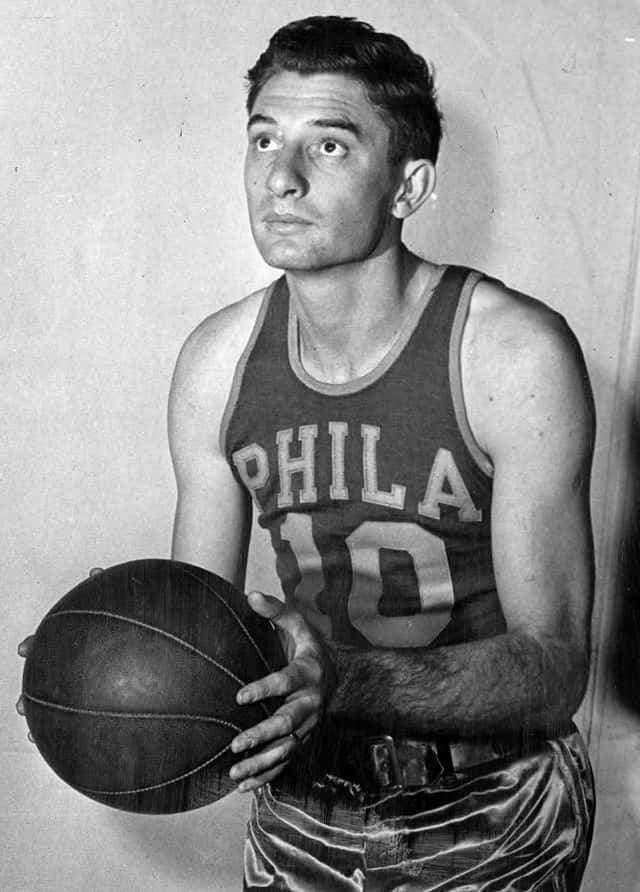The Babe Ruth of Basketball:
Jumpin’ Joe Fulks
Written by Justin D. Lamb

Known as the “Babe Ruth of Basketball,” Marshall County’s very own Joseph Franklin Fulks revolutionized the game of basketball and made it into the great game we all know and love today. As one of the first high scoring forwards, Fulks received the nickname “Jumping Joe” and is credited with being the first true superstar of the modern game of basketball.
The son of Leonard Fulks and Mattie Jo Estes, Joe Fulks was born on his father’s farm on October 26, 1921 in the now inundated town of Birmingham, Kentucky. It wasn’t until the age of eight that Fulks saw his first basketball game when he caught a game of the Birmingham High School basketball team in action. He soon began making regular visits to the school’s outdoor basketball court at night where he would throw tin cans through the hoop. When the coach made the discovery as to who was ripping his nets with tin cans, he gave Fulks a basketball to practice with instead.
By the time of his high school years, Fulks began playing for Birmingham High School where with his flashy spinning style annoyed his coach to no end. Fulks was forced to tone his style down, but in his spare time he worked to perfect his exceptional style. He soon played basketball for Birmingham High School until residents of the town were forced to relocate after the Tennessee Valley Authority dammed the Tennessee River in order to create the Kentucky Lake and bring much needed electricity and flood control to the economically depressed area of western Kentucky.
Fulks transferred to Kuttawa High School in Lyon County and it was here his coach embraced his style of play. Fulks became known as the “Kuttawa Klipper” as he broke every state scoring record. Following graduation, he enrolled at Murray State University where he played college ball for two years and his number 26 hangs in the rafters of the CFSB center.
Fulks joined the United States Marines in 1942, serving in the South Pacific where he spent a majority of his military time playing with Marines All Star Squad. After being discharged in May 1946 at the age of 25, Fulks was hired to play for the Philadelphia Warriors, a team of the Basketball Association of America which was “competing with the National Basketball League for players, fans, and credibility.” Philadelphia Warriors coach and owner Ed Gottlieb was looking for a player who could be a superstar. Someone who could “fill the seats as well as the baskets.” He found that star in Fulks who was signed at $5,000 a year. That figure was later increased to $8,000 a year plus a new car as a bonus after Fulks began receiving several offers from other teams.
During his first season, Fulks averaged 23.2 points per game and his team won the BAA title. By the 1949 season, Fulks scored 63 points in a single game in the Warriors stunning 108-87 win over the Indianapolis Jets and “set the standard against which all future scores would be judged.” During the game, Fulks made 27 of 56 shots from the field and 9 of 14 from the free-throw line, and impressively, he didn’t miss two consecutive shots until the third period. “Five different Jets took a turn guarding him. What made Fulks’ feat even more impressive was that it came before the advent of the 24-second shot clock, when teams were averaging around 80 points.”
Fulks had a unique style of play and it is credited as being the innovator of the jump shot. “His version of the move was different from its current form,” according to his NBA Legends Profile, “he usually left the ground and then spun in either direction before releasing the ball with one hand. Fulks astonished fans and players alike by transferring the ball from one hand to the other while in midair. He also excelled at firing turnaround jumpers, shooting on the run with either hand, and hitting from outside with his looping set shot.”
Additionally, Fulks was a lethal free throw shooter. In the 1950-51 season, Fulks twice made 49 attempts in a row. “The unsophisticated, flat-footed defenses of the day were virtually helpless against Fulks and his arsenal of scoring weapons.”
While his style of play thrilled his coach and fans, it gave opposing coaches headaches including Boston Celtics coach Red Auerbach. “He could shoot from anyplace,” Auerbach later commented. “We set up our defense around him.”
After only seven short years where he shattered previous records and made several new ones, Fulks retired from professional basketball at age 32. Fulks returned home to Kentucky and went to work at GAF Corporation in Calvert City. He later became recreation director at the Kentucky State Penitentiary in Eddyville. Basketball stayed in his blood and he served as a basketball scout for the Philadelphia Warriors until 1965.
In 1970, Fulks was named to the NBA Silver Anniversary Team with other former stars including Bob Cousy and Bill Russell among others. He was voted a member of the National Association of Intercollegiate Athletics Hall of Fame and is a member of the Murray State Hall of Fame and Marshall County High School Athletic Hall of Fame.
Fulks life came to a tragic end on March 21, 1976 when he was shot and killed by Gregg Bannister, the son of his girlfriend following an argument over a handgun. He was laid to rest in the Birmingham Cemetery in his native Marshall County. The following year he was posthumously inducted into the Naismith Memorial Basketball Hall of Fame. Though he only played professionally for seven years, Fulks changed the face of the game like no other. He was an innovator with style and a true basketball legend in every sense of the word.






